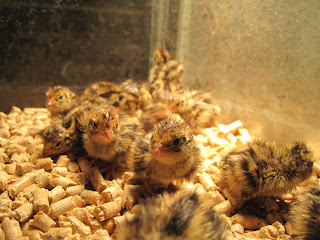Now you may wonder, Why Coturnix? They are just quail used for hunting, correct? You may be mistaken for other quail species, as there are quite a few. The Coturnix is a great dual purpose bird, however they are known primarily for their meat. In your 8 facts, you will find out why these birds are so valuable. Stick tight, and enjoy the fun in these fascinating creatures.
8. Coturnix are Cold Hardy

Photo courtesy Stoney Creek Farms
Coturnix are really well at adapting to different environments. There are many in Alaska and in Minnesota and thriving in that weather. They are extremely cold hardy and heat tolerant compared to other species of quail. Making sure their cages is away from draft is ideal, however, to ensure they do not get chilled but temperature should not be an issue but do what their behavior. Provide some more corn in their diet during colder months to help them with body heat. There has been cases of Coturnix doing well with 12 Degrees F but in every location, this can change. Do note, these are temperature tolerant birds but supplement lighting or fans may be needed at times.
7. Noise is not a Problem

The Coturnix Cock is not like a Rooster. He sounds more of an outside bird and it is hard for outsiders to distinguish what the sound is. Hens sound like crickets. These birds do make great apartment birds and can be kept in the house and garage. It is a great city limits bird. The Male stands erect and make a trill sound that is fun to hear.
6. Coturnix are Fast Growers.

What makes Coturnix so fascinating is that they mature in 6 weeks of age! This makes them perfect as a meat bird due to their fast turn out. They have a good feed conversion ratio to protein. Quail meat is a delicacy for the Asian culture and marketing is an option for those that want to get started. This is a dark meat bird and very tasty. There are Jumbo varieties of coturnix which contain even more meat on them. This is the perfect bird for the homesteader. A covey of a cock and 6 hens can feed a family of 4 with eggs and their offspring! I bet you didn't know that!?
5. Coturnix have a quick Sexual Maturity.

With the fast grow out rate, sexual maturity is also 6 weeks of age! This means that hens will start laying around this time. With artificial lighting in the autumn months, Coturnix can lay all year round. One hen can lay 300+ eggs a year!
4. Coturnix are not particular to Housing.

Coturnix require very little space! The rule of thumb is one square foot per bird! That is a very little requirement and with the birds fast producing rate, you can stack up cages and have your little quail farm in no time! Rabbit hutches, cages, battery cages, all work well for these guys.
3. Fast Incubation Period.

If you are planning to incubate your Coturnix eggs, it only takes 17 days to incubate them, compared to a chicken egg that takes 21 days. It only takes 6 weeks for them to mature and lay eggs or go to freezer camp!
2. Coturnix eggs are nutritious!
.JPG)
If you have allergies or illnesses, have you ever considered coturnix eggs? Did you know how nutritious these eggs are to your health? Their nutrition value is 3-4 times greater to that of chicken eggs! Now that is something to consider!
1. If you are not interested in Butchering, Coturnix make wonderful pets that can produce for you and your family. Coturnix are a valuable commodity and we need to promote them to the public on their many uses. We at Stellar Game birds, Poultry, and Waterfowl, strive to preserve these wonderful creatures and let others know Coturnix are not throw away pets or "just for beginners," but rather a bird that is perfect for the homesteader. When picking out your bird, consider the Coturnix. If you would like to learn more about the Coturnix, click here.







.JPG)



























